Deck 15: Fourier Analysis Techniques
سؤال
سؤال
سؤال
سؤال
سؤال
سؤال
سؤال
سؤال
سؤال
سؤال
سؤال
سؤال
سؤال
سؤال
سؤال
سؤال
سؤال
سؤال
سؤال
سؤال
سؤال
سؤال
سؤال
سؤال
سؤال
سؤال
سؤال
سؤال
سؤال
سؤال
سؤال
سؤال
سؤال
سؤال
سؤال
سؤال
سؤال
سؤال
سؤال
سؤال
سؤال
سؤال
سؤال
سؤال
سؤال
سؤال
سؤال
سؤال
سؤال
سؤال
سؤال
سؤال
سؤال
سؤال
سؤال
سؤال
سؤال
سؤال
سؤال
سؤال
سؤال
سؤال
سؤال
سؤال
سؤال
سؤال
سؤال
سؤال
سؤال
سؤال
سؤال
سؤال
سؤال
سؤال
سؤال
سؤال
سؤال
سؤال
سؤال
سؤال

فتح الحزمة
قم بالتسجيل لفتح البطاقات في هذه المجموعة!
Unlock Deck
Unlock Deck
1/94
العب
ملء الشاشة (f)
Deck 15: Fourier Analysis Techniques
1
Find the trigonometric Fourier series for the voltage waveform in Fig. E15.4.
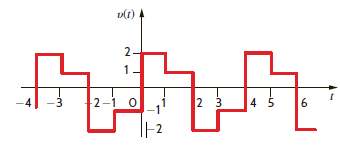
Figure E15.4

Figure E15.4
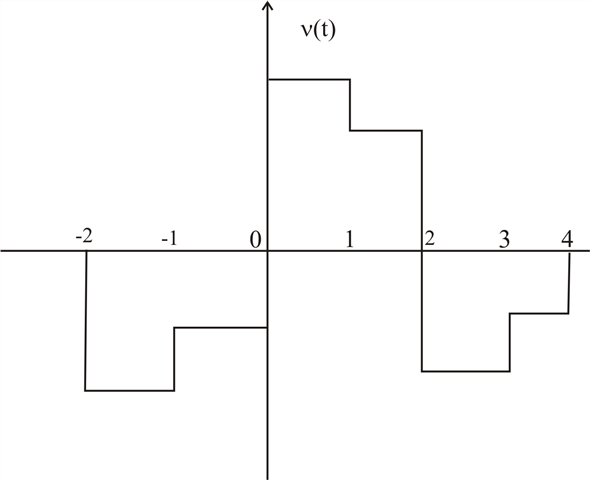 Given figure is of half wave summitry. So,
Given figure is of half wave summitry. So, 


















2
Determine the first three terms of the steady-state current i ( t ) in Fig. E15.14 if the input voltage is given by

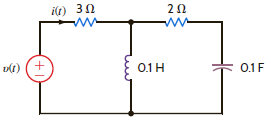
Figure E15.14


Figure E15.14
Refer to Figure E15.14 in the textbook.
The input voltage is,
 The input signal expression can be expanded as,
The input signal expression can be expanded as,
 The equivalent resistance of the network is,
The equivalent resistance of the network is,

 The Fourier transform of the current,
The Fourier transform of the current,
 is expressed as,
is expressed as,
 Substitute the values of
Substitute the values of
 and
and
 in the equation of current.
in the equation of current.
 …… (1)
…… (1)
The components of
 due to the frequency components present in the input voltage are as follows:
due to the frequency components present in the input voltage are as follows:
There is a dc component present in the voltage signal. At zero frequency that is, at
 , the value of current is,
, the value of current is,
 Substitute 10 in place of
Substitute 10 in place of
 in equation (1).
in equation (1).
 Substitute 20 in place of
Substitute 20 in place of
 in equation (1).
in equation (1).
 Hence, the first three terms of the steady state current
Hence, the first three terms of the steady state current
 are,
are,
 .
.
The input voltage is,
 The input signal expression can be expanded as,
The input signal expression can be expanded as, The equivalent resistance of the network is,
The equivalent resistance of the network is,
 The Fourier transform of the current,
The Fourier transform of the current,  is expressed as,
is expressed as, Substitute the values of
Substitute the values of  and
and  in the equation of current.
in the equation of current. …… (1)
…… (1)The components of
 due to the frequency components present in the input voltage are as follows:
due to the frequency components present in the input voltage are as follows:There is a dc component present in the voltage signal. At zero frequency that is, at
 , the value of current is,
, the value of current is, Substitute 10 in place of
Substitute 10 in place of  in equation (1).
in equation (1). Substitute 20 in place of
Substitute 20 in place of  in equation (1).
in equation (1). Hence, the first three terms of the steady state current
Hence, the first three terms of the steady state current  are,
are,  .
. 3
Find the trigonometric Fourier series coefficients for the waveform in Fig. P15.22.

Figure P15.22

Figure P15.22
Refer to periodic waveform in Figure P15.22 in the textbook.
The voltage expression is,
 The period is,
The period is,
 The fundamental frequency is,
The fundamental frequency is,
 The trigonometric Fourier series coefficients are,
The trigonometric Fourier series coefficients are,
 Calculate the trigonometric Fourier series coefficient
Calculate the trigonometric Fourier series coefficient
 .
.

 Calculate the trigonometric Fourier series coefficient
Calculate the trigonometric Fourier series coefficient
 .
.
 It is known that,
It is known that,
 Therefore,
Therefore,
 Substitute
Substitute
 for
for
 .
.
 Calculate the trigonometric Fourier series coefficient
Calculate the trigonometric Fourier series coefficient
 .
.
 It is known that,
It is known that,
 Therefore,
Therefore,
 Substitute
Substitute
 for
for
 .
.
 Therefore, the trigonometric Fourier series coefficients are,
Therefore, the trigonometric Fourier series coefficients are,
 .
.
The voltage expression is,
 The period is,
The period is, The fundamental frequency is,
The fundamental frequency is, The trigonometric Fourier series coefficients are,
The trigonometric Fourier series coefficients are, Calculate the trigonometric Fourier series coefficient
Calculate the trigonometric Fourier series coefficient  .
.
 Calculate the trigonometric Fourier series coefficient
Calculate the trigonometric Fourier series coefficient  .
. It is known that,
It is known that, Therefore,
Therefore, Substitute
Substitute  for
for  .
. Calculate the trigonometric Fourier series coefficient
Calculate the trigonometric Fourier series coefficient  .
.  It is known that,
It is known that, Therefore,
Therefore, Substitute
Substitute  for
for  .
. Therefore, the trigonometric Fourier series coefficients are,
Therefore, the trigonometric Fourier series coefficients are, .
. 4
The discrete line spectrum for a periodic function f ( t ) is shown in Fig. P15.38. Determine the expression for f ( t ).
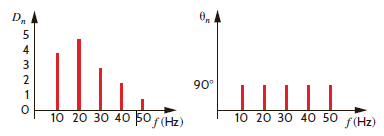
Figure P15.38

Figure P15.38

فتح الحزمة
افتح القفل للوصول البطاقات البالغ عددها 94 في هذه المجموعة.
فتح الحزمة
k this deck
5
Derive the Fourier transform for the following functions:
(a) f ( t ) = e 2 t cos 4 tu ( t )
(b) f ( t ) = e 2 t sin 4 tu ( t )
(a) f ( t ) = e 2 t cos 4 tu ( t )
(b) f ( t ) = e 2 t sin 4 tu ( t )

فتح الحزمة
افتح القفل للوصول البطاقات البالغ عددها 94 في هذه المجموعة.
فتح الحزمة
k this deck
6
Find the Fourier coefficients for the waveform in Fig. E15.1.
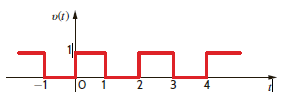
Figure E15.1

Figure E15.1

فتح الحزمة
افتح القفل للوصول البطاقات البالغ عددها 94 في هذه المجموعة.
فتح الحزمة
k this deck
7
Show that the exponential Fourier series for the periodic function f ( t ) = e t , 1 t 1 with period 2, can be expressed as



فتح الحزمة
افتح القفل للوصول البطاقات البالغ عددها 94 في هذه المجموعة.
فتح الحزمة
k this deck
8
Derive the exponential Fourier series for the function v ( t ) = A| sin t | shown in Fig. P15.14.
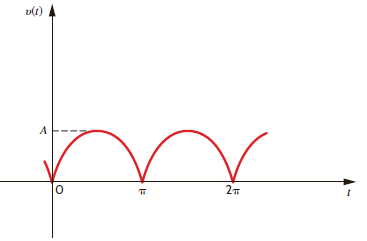
Figure P15.14

Figure P15.14

فتح الحزمة
افتح القفل للوصول البطاقات البالغ عددها 94 في هذه المجموعة.
فتح الحزمة
k this deck
9
Find the trigonometric Fourier series coefficients for the waveform in Fig. P15.23.

Figure P15.23

Figure P15.23

فتح الحزمة
افتح القفل للوصول البطاقات البالغ عددها 94 في هذه المجموعة.
فتح الحزمة
k this deck
10
Plot the first four terms of the amplitude and phase spectra for the signal



فتح الحزمة
افتح القفل للوصول البطاقات البالغ عددها 94 في هذه المجموعة.
فتح الحزمة
k this deck
11
Show that



فتح الحزمة
افتح القفل للوصول البطاقات البالغ عددها 94 في هذه المجموعة.
فتح الحزمة
k this deck
12
Given the waveform in Fig. 15PFE-1, determine if the trigonometric Fourier coefficient a n has zero value or nonzero value and why.

Figure 15PFE-1
a. a n = 0 for n even due to half-wave symmetry
b. a n = 0 for all n due to odd symmetry
c. a n is finite and nonzero for all n
d. a n is finite and nonzero for n even

Figure 15PFE-1
a. a n = 0 for n even due to half-wave symmetry
b. a n = 0 for all n due to odd symmetry
c. a n is finite and nonzero for all n
d. a n is finite and nonzero for n even

فتح الحزمة
افتح القفل للوصول البطاقات البالغ عددها 94 في هذه المجموعة.
فتح الحزمة
k this deck
13
Determine the trigonometric Fourier series for the waveform shown in Fig. E15.3.
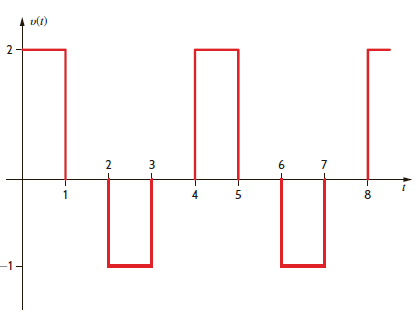
Figure E15.3

Figure E15.3

فتح الحزمة
افتح القفل للوصول البطاقات البالغ عددها 94 في هذه المجموعة.
فتح الحزمة
k this deck
14
Find the average power absorbed by the network in Fig. E15.15 if

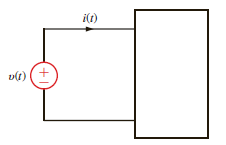
Figure E15.15


Figure E15.15

فتح الحزمة
افتح القفل للوصول البطاقات البالغ عددها 94 في هذه المجموعة.
فتح الحزمة
k this deck
15
Find the trigonometric Fourier series coefficients for the waveform in Fig. P15.24.

Figure P15.24

Figure P15.24

فتح الحزمة
افتح القفل للوصول البطاقات البالغ عددها 94 في هذه المجموعة.
فتح الحزمة
k this deck
16
Determine the steady-state response of the current i o ( t ) in the circuit shown in Fig. P15.40 if the input voltage is described by the waveform shown in Problem 15.25.
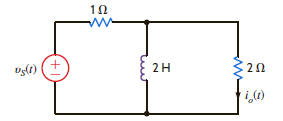
Figure P15.40
Problem 15.25
Derive the trigonometric Fourier series for the waveform shown in Fig. P15.25.

Figure P15.25

Figure P15.40
Problem 15.25
Derive the trigonometric Fourier series for the waveform shown in Fig. P15.25.

Figure P15.25

فتح الحزمة
افتح القفل للوصول البطاقات البالغ عددها 94 في هذه المجموعة.
فتح الحزمة
k this deck
17
Use the transform technique to find v o ( t ) in the network in Fig. P15.43a if (a) i ( t ) = 4( e t e 2 t )u ( t ) A and (b) i ( t ) = 12 cos 4 t A.

فتح الحزمة
افتح القفل للوصول البطاقات البالغ عددها 94 في هذه المجموعة.
فتح الحزمة
k this deck
18
Find the exponential Fourier series for the periodic signal shown in Fig. P15.1.
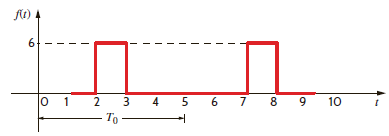
Figure P15.1

Figure P15.1

فتح الحزمة
افتح القفل للوصول البطاقات البالغ عددها 94 في هذه المجموعة.
فتح الحزمة
k this deck
19
Find the exponential Fourier series for the voltage waveform shown in Fig. P15.7.
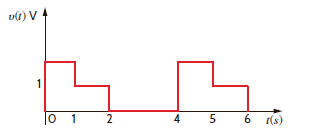
Figure P15.7

Figure P15.7

فتح الحزمة
افتح القفل للوصول البطاقات البالغ عددها 94 في هذه المجموعة.
فتح الحزمة
k this deck
20
Sketch the missing section in the periodic function shown in Fig. P15.15 between T /2 and T , which will make (a) a 0 = 0, a n = 0 and (b) b n = 0.
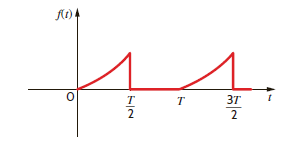
Figure P15.15

Figure P15.15

فتح الحزمة
افتح القفل للوصول البطاقات البالغ عددها 94 في هذه المجموعة.
فتح الحزمة
k this deck
21
Derive the trigonometric Fourier series for the waveform shown in Fig. P15.25.

Figure P15.25

Figure P15.25

فتح الحزمة
افتح القفل للوصول البطاقات البالغ عددها 94 في هذه المجموعة.
فتح الحزمة
k this deck
22
Determine the first three terms of the steady-state voltage v o ( t ) in Fig. P15.41 if the input voltage is a periodic signal of the form

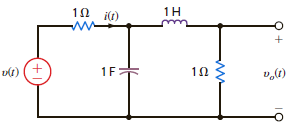
Figure P15.41


Figure P15.41

فتح الحزمة
افتح القفل للوصول البطاقات البالغ عددها 94 في هذه المجموعة.
فتح الحزمة
k this deck
23
The input signal to a network is v i ( t ) = e 3 u ( t ) V. The transfer function of the network is H ( j ) = 1 / ( j + 4). Find the output of the network v o ( t ) if the initial conditions are zero.

فتح الحزمة
افتح القفل للوصول البطاقات البالغ عددها 94 في هذه المجموعة.
فتح الحزمة
k this deck
24
Find the Fourier coefficients for the waveform in Fig. E15.2.
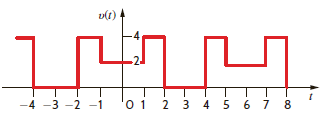
Figure E15.2

Figure E15.2

فتح الحزمة
افتح القفل للوصول البطاقات البالغ عددها 94 في هذه المجموعة.
فتح الحزمة
k this deck
25
If the waveform in Fig. E15.1 is time-delayed 1 is, we obtain the waveform in Fig. E15.8. Compute the exponential Fourier coefficients for the waveform in Fig. E15.8 and show that they differ from the coefficients for the waveform in Fig. E15.1 by an angle n (180°).
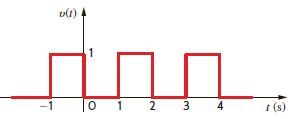
Figure E15.8
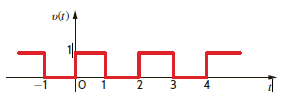
Figure E15.1

Figure E15.8

Figure E15.1

فتح الحزمة
افتح القفل للوصول البطاقات البالغ عددها 94 في هذه المجموعة.
فتح الحزمة
k this deck
26
If f ( t ) = sin 0 t , find F ( ).

فتح الحزمة
افتح القفل للوصول البطاقات البالغ عددها 94 في هذه المجموعة.
فتح الحزمة
k this deck
27
Find the trigonometric Fourier series for the waveform shown in Fig. P15.26.
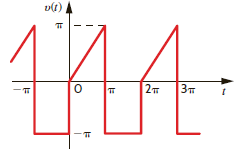
Figure P15.26

Figure P15.26

فتح الحزمة
افتح القفل للوصول البطاقات البالغ عددها 94 في هذه المجموعة.
فتح الحزمة
k this deck
28
Find the average power absorbed by the network in Fig. P15.42 if
v ( t ) = 12 + 6 cos (377 t 10°) + 4 cos (754 t 60°)V
i ( t ) = 0.2 + 0.4 cos (377 t 150°) 0.2 cos (754 t 80°) + 0.1 cos (1131 t 60°) A
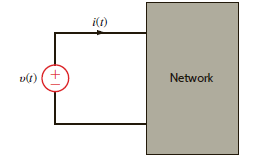
Figure P15.42
v ( t ) = 12 + 6 cos (377 t 10°) + 4 cos (754 t 60°)V
i ( t ) = 0.2 + 0.4 cos (377 t 150°) 0.2 cos (754 t 80°) + 0.1 cos (1131 t 60°) A

Figure P15.42

فتح الحزمة
افتح القفل للوصول البطاقات البالغ عددها 94 في هذه المجموعة.
فتح الحزمة
k this deck
29
Determine v o ( t ) in the circuit shown in Fig. P15.58 using the Fourier transform if the input signal is i s ( t ) = ( e 2 t + cos t ) u ( t ) A.
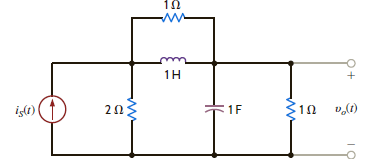
Figure P15.58

Figure P15.58

فتح الحزمة
افتح القفل للوصول البطاقات البالغ عددها 94 في هذه المجموعة.
فتح الحزمة
k this deck
30
Given the waveform in Fig. 15PFE-2, describe the type of symmetry and its impact on the trigonometric Fourier coefficient b n.
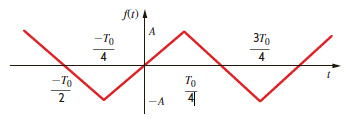
Figure 15PFE-2
a. b n = 0 for n even due to odd symmetry; b n is nonzero for n odd
b. b n is nonzero for all n
c. b n = 0 for all n due to half-wave symmetry
d. b n = 0 for n even due to half-wave symmetry; b n is nonzero for n odd

Figure 15PFE-2
a. b n = 0 for n even due to odd symmetry; b n is nonzero for n odd
b. b n is nonzero for all n
c. b n = 0 for all n due to half-wave symmetry
d. b n = 0 for n even due to half-wave symmetry; b n is nonzero for n odd

فتح الحزمة
افتح القفل للوصول البطاقات البالغ عددها 94 في هذه المجموعة.
فتح الحزمة
k this deck
31
If the waveform in Problem 15.7 is time-delayed 1 second, we obtain the waveform shown in Fig. P15.8. Compute the exponential Fourier coefficients for this latter waveform and show that they differ from those for the waveform in Problem 15.7 by n (90°).
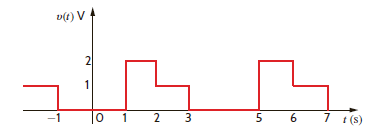
Figure P15.8
Problem 15.7
Find the exponential Fourier series for the voltage waveform shown in Fig. P15.7.
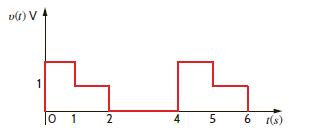
Figure P15.7

Figure P15.8
Problem 15.7
Find the exponential Fourier series for the voltage waveform shown in Fig. P15.7.

Figure P15.7

فتح الحزمة
افتح القفل للوصول البطاقات البالغ عددها 94 في هذه المجموعة.
فتح الحزمة
k this deck
32
Determine which of the Fourier coefficients are zero for f ( t ) shown in Fig. P15.16.
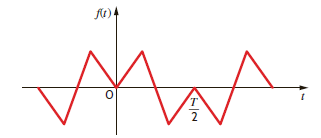
Figure P15.16

Figure P15.16

فتح الحزمة
افتح القفل للوصول البطاقات البالغ عددها 94 في هذه المجموعة.
فتح الحزمة
k this deck
33
Derive the trigonometric Fourier series for the function shown in Fig. P15.27.
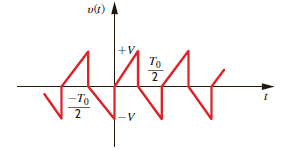
Figure P15.27

Figure P15.27

فتح الحزمة
افتح القفل للوصول البطاقات البالغ عددها 94 في هذه المجموعة.
فتح الحزمة
k this deck
34
Determine the steady-state voltage v o ( t ) in the network in Fig. P15.43a if the input current is given in Fig. P15.43b.
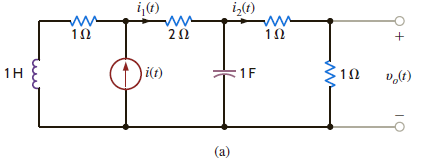
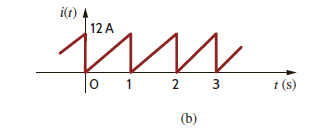
Figure P15.43


Figure P15.43

فتح الحزمة
افتح القفل للوصول البطاقات البالغ عددها 94 في هذه المجموعة.
فتح الحزمة
k this deck
35
Use the Fourier transform to find i ( t ) in the network in Fig. P15.59 if v i ( t ) = 2 e t u ( t ).

Figure P15.59

Figure P15.59

فتح الحزمة
افتح القفل للوصول البطاقات البالغ عددها 94 في هذه المجموعة.
فتح الحزمة
k this deck
36
Find the exponential Fourier series for the signal shown in Fig. P15.2.
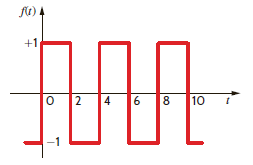
Figure P15.2

Figure P15.2

فتح الحزمة
افتح القفل للوصول البطاقات البالغ عددها 94 في هذه المجموعة.
فتح الحزمة
k this deck
37
Two periodic waveforms are shown in Fig. E15.9. Compute the exponential Fourier series for each waveform, and then add the results to obtain the Fourier series for the waveform in Fig. E15.2.

Figure E15.9
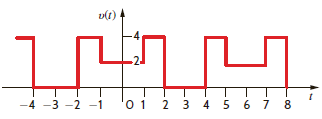
Figure. E15.2

Figure E15.9

Figure. E15.2

فتح الحزمة
افتح القفل للوصول البطاقات البالغ عددها 94 في هذه المجموعة.
فتح الحزمة
k this deck
38
Determine the output v o ( t ) in Fig. E15.17 if the signal v i ( t ) = e t u ( t ) V, the network impulse response h ( t ) = e 2 t u ( t ), and all initial conditions are zero.

Figure E15.17

Figure E15.17

فتح الحزمة
افتح القفل للوصول البطاقات البالغ عددها 94 في هذه المجموعة.
فتح الحزمة
k this deck
39
Derive the trigonometric Fourier series of the waveform shown in Fig. P15.28.
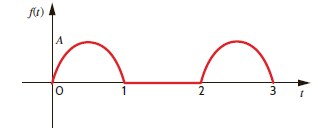
Figure P15.28

Figure P15.28

فتح الحزمة
افتح القفل للوصول البطاقات البالغ عددها 94 في هذه المجموعة.
فتح الحزمة
k this deck
40
Determine the steady-state voltage v o ( t ) in the circuit shown in Fig. P15.44a if the input signal is shown in Fig. P15.44b.
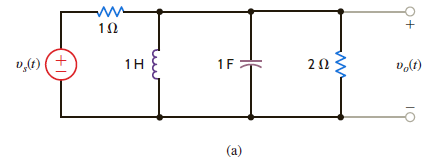
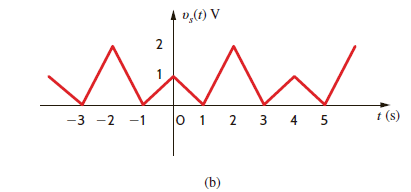
Figure P15.44


Figure P15.44

فتح الحزمة
افتح القفل للوصول البطاقات البالغ عددها 94 في هذه المجموعة.
فتح الحزمة
k this deck
41
Use the transform technique to find v o ( t ) in the network in Fig. P15.60 if (a) v i ( t ) = 4 e t u (t) V and (b) v i ( t ) = 4( e 2 t + 2 e 4 t ) u ( t ) V.

Figure P15.60

Figure P15.60

فتح الحزمة
افتح القفل للوصول البطاقات البالغ عددها 94 في هذه المجموعة.
فتح الحزمة
k this deck
42
Find the exponential Fourier series for the waveform shown in Fig. E15.3.
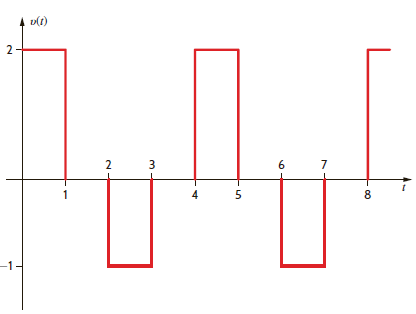
Figure E15.3

Figure E15.3

فتح الحزمة
افتح القفل للوصول البطاقات البالغ عددها 94 في هذه المجموعة.
فتح الحزمة
k this deck
43
What type of symmetry is exhibited by the two waveforms in Fig. P15.9
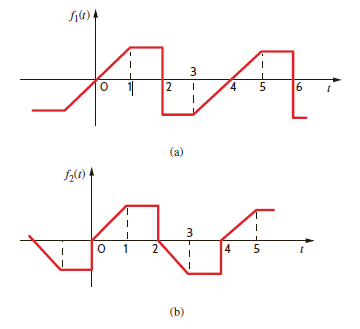
Figure P15.9

Figure P15.9

فتح الحزمة
افتح القفل للوصول البطاقات البالغ عددها 94 في هذه المجموعة.
فتح الحزمة
k this deck
44
Find the trigonometric Fourier series for the voltage waveform shown in Fig. P15.17.
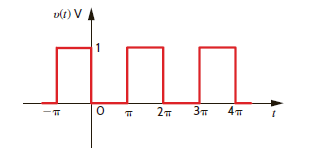
Figure P15.17

Figure P15.17

فتح الحزمة
افتح القفل للوصول البطاقات البالغ عددها 94 في هذه المجموعة.
فتح الحزمة
k this deck
45
Derive the trigonometric Fourier series for the function v ( t ) = A|sin t| as shown in Fig. P15.29.

Figure P15.29

Figure P15.29

فتح الحزمة
افتح القفل للوصول البطاقات البالغ عددها 94 في هذه المجموعة.
فتح الحزمة
k this deck
46
Find the average power absorbed by the network in Fig. P15.45 if
v ( t ) = 60 + 36 cos (377 t + 45°) + 24 cos (754 t 60°) V

Figure P15.45
v ( t ) = 60 + 36 cos (377 t + 45°) + 24 cos (754 t 60°) V

Figure P15.45

فتح الحزمة
افتح القفل للوصول البطاقات البالغ عددها 94 في هذه المجموعة.
فتح الحزمة
k this deck
47
Determine the total 1- energy content of the signal v ( t ) = ( e t e 2 t ) u ( t ).

فتح الحزمة
افتح القفل للوصول البطاقات البالغ عددها 94 في هذه المجموعة.
فتح الحزمة
k this deck
48
Determine the first three nonzero terms of the voltage v o ( t ) in the circuit in Fig. 15PFE-3 if the input voltage v s ( t ) is given by the expression


Figure 15PFE-3
a. 8.54 cos (2 t + 26.57°) + 4.63 cos (4 t + 14.04°) + 3.14 cos (6 t + 9.46°) +... V
b. 10.82 cos(2 t + 35.63°) + 6.25cos(4 t + 18.02°) + 2.16 cos (6 t + 30.27°) +... V
c. 4.95cos(2 t 25.43°) + 3.19cos(4 t + 60.34°) + 1.78 cos (6 t 20.19°) +... V
d. 7.35cos(2 t + 50.12°) + 4.61cos(4 t + 21.24°) + 2.28 cos (6 t 10.61°) +... V


Figure 15PFE-3
a. 8.54 cos (2 t + 26.57°) + 4.63 cos (4 t + 14.04°) + 3.14 cos (6 t + 9.46°) +... V
b. 10.82 cos(2 t + 35.63°) + 6.25cos(4 t + 18.02°) + 2.16 cos (6 t + 30.27°) +... V
c. 4.95cos(2 t 25.43°) + 3.19cos(4 t + 60.34°) + 1.78 cos (6 t 20.19°) +... V
d. 7.35cos(2 t + 50.12°) + 4.61cos(4 t + 21.24°) + 2.28 cos (6 t 10.61°) +... V

فتح الحزمة
افتح القفل للوصول البطاقات البالغ عددها 94 في هذه المجموعة.
فتح الحزمة
k this deck
49
Determine the trigonometric Fourier series for the voltage waveform in Fig. E15.10 and plot the first four terms of the amplitude and phase spectra for this signal.
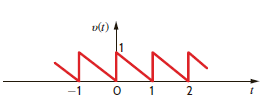
Figure E15.10

Figure E15.10

فتح الحزمة
افتح القفل للوصول البطاقات البالغ عددها 94 في هذه المجموعة.
فتح الحزمة
k this deck
50
Use the transform technique to find v o ( t ) in Fig. E15.18 if u ( t ) = 15 cos 10 t V.
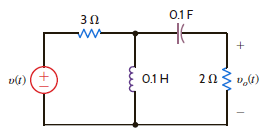
Figure E15.18

Figure E15.18

فتح الحزمة
افتح القفل للوصول البطاقات البالغ عددها 94 في هذه المجموعة.
فتح الحزمة
k this deck
51
The amplitude and phase spectra for a periodic function v ( t ) that has only a small number of terms is shown in Fig. P15.30. Determine the expression for v ( t ) if T 0 = 0.1 s.
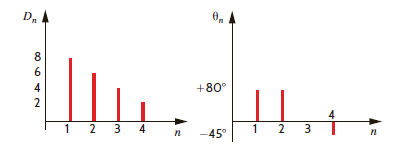
Figure P15.30

Figure P15.30

فتح الحزمة
افتح القفل للوصول البطاقات البالغ عددها 94 في هذه المجموعة.
فتح الحزمة
k this deck
52
Find the average power absorbed by the 12- resistor in the network in Fig. P15.45 if
v ( t ) = 50 + 25 cos (377 t + 45°) + 12.5 cos (754 t 45°) V.
v ( t ) = 50 + 25 cos (377 t + 45°) + 12.5 cos (754 t 45°) V.

فتح الحزمة
افتح القفل للوصول البطاقات البالغ عددها 94 في هذه المجموعة.
فتح الحزمة
k this deck
53
Determine the 1- energy content of the signal in Problem 15.61 in the frequency band from 0 to 1 rad/s.
Problem 15.61
Determine the total 1- energy content of the signal v ( t ) = ( e t e 2 t ) u ( t ).
Problem 15.61
Determine the total 1- energy content of the signal v ( t ) = ( e t e 2 t ) u ( t ).

فتح الحزمة
افتح القفل للوصول البطاقات البالغ عددها 94 في هذه المجموعة.
فتح الحزمة
k this deck
54
Find the exponential Fourier series for the periodic pulse train shown in Fig. P15.3.

Figure P15.3

Figure P15.3

فتح الحزمة
افتح القفل للوصول البطاقات البالغ عددها 94 في هذه المجموعة.
فتح الحزمة
k this deck
55
Find the trigonometric Fourier series for the waveform shown in Fig. P15.10.
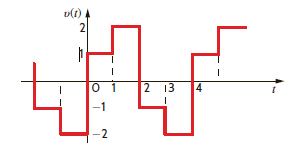
Figure P15.10

Figure P15.10

فتح الحزمة
افتح القفل للوصول البطاقات البالغ عددها 94 في هذه المجموعة.
فتح الحزمة
k this deck
56
Find the trigonometric Fourier series coefficients for the waveform in Fig. P15.18.

Figure P15.18

Figure P15.18

فتح الحزمة
افتح القفل للوصول البطاقات البالغ عددها 94 في هذه المجموعة.
فتح الحزمة
k this deck
57
Find the trigonometric Fourier series coefficients for the waveform in Fig. P15.31.

Figure P15.31

Figure P15.31

فتح الحزمة
افتح القفل للوصول البطاقات البالغ عددها 94 في هذه المجموعة.
فتح الحزمة
k this deck
58
Determine the Fourier transform of the waveform shown in Fig. P15.47.
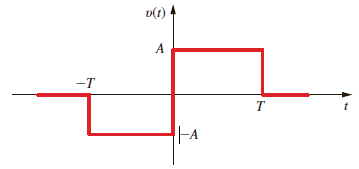
Figure P15.47

Figure P15.47

فتح الحزمة
افتح القفل للوصول البطاقات البالغ عددها 94 في هذه المجموعة.
فتح الحزمة
k this deck
59
Determine the relationship between the 1- energy at the input and output of the network shown in Fig. P15.63.
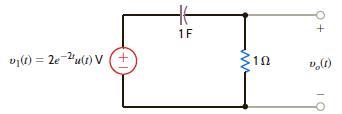
Figure P15.63

Figure P15.63

فتح الحزمة
افتح القفل للوصول البطاقات البالغ عددها 94 في هذه المجموعة.
فتح الحزمة
k this deck
60
Determine the type of symmetry exhibited by the waveform in Figs. E15.2 and E15.4.
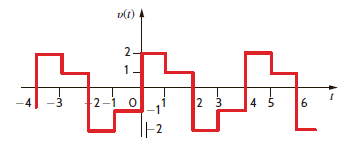
Figure E15.4
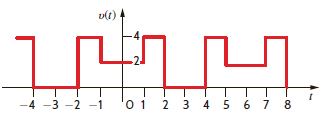
Figure E15.2

Figure E15.4

Figure E15.2

فتح الحزمة
افتح القفل للوصول البطاقات البالغ عددها 94 في هذه المجموعة.
فتح الحزمة
k this deck
61
The discrete line spectrum for a periodic function is shown in Fig. E15.11. Determine the expression for f ( t ).
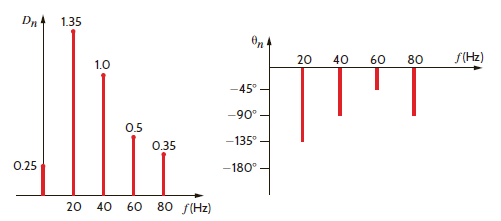
Figure E15.11

Figure E15.11

فتح الحزمة
افتح القفل للوصول البطاقات البالغ عددها 94 في هذه المجموعة.
فتح الحزمة
k this deck
62
Compute the total 1- energy content of the signal v i ( t ) = e 2 t u ( t ) V using both the time-domain and frequency-domain approaches.

فتح الحزمة
افتح القفل للوصول البطاقات البالغ عددها 94 في هذه المجموعة.
فتح الحزمة
k this deck
63
Plot the first four terms of the amplitude and phase spectra for the following signal.



فتح الحزمة
افتح القفل للوصول البطاقات البالغ عددها 94 في هذه المجموعة.
فتح الحزمة
k this deck
64
Find the Fourier transform of the function f ( t ) = sin 0 t.

فتح الحزمة
افتح القفل للوصول البطاقات البالغ عددها 94 في هذه المجموعة.
فتح الحزمة
k this deck
65
The input signal for the network in Fig. P15.64 is v i ( t ) = 10 e 5 t u ( t ) V. Determine the total 1- energy content of the output v o ( t ).
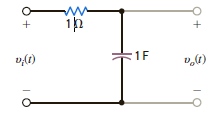
Figure P15.64

Figure P15.64

فتح الحزمة
افتح القفل للوصول البطاقات البالغ عددها 94 في هذه المجموعة.
فتح الحزمة
k this deck
66
Find the average power absorbed by the network in Fig. 15PFE-4 if
v s ( t ) = 20 + 10 cos (377 t + 60°) + 4 cos (1131 t + 45°) V
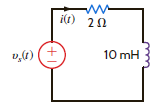
Figure 15PFE-4
a. 175.25 W
b. 205.61 W
c. 150.36 W
d. 218.83 W
v s ( t ) = 20 + 10 cos (377 t + 60°) + 4 cos (1131 t + 45°) V

Figure 15PFE-4
a. 175.25 W
b. 205.61 W
c. 150.36 W
d. 218.83 W

فتح الحزمة
افتح القفل للوصول البطاقات البالغ عددها 94 في هذه المجموعة.
فتح الحزمة
k this deck
67
Compute the exponential Fourier series for the waveform that is the sum of the two waveforms in Fig. P15.11 by computing the exponential Fourier series of the two waveforms and adding them.
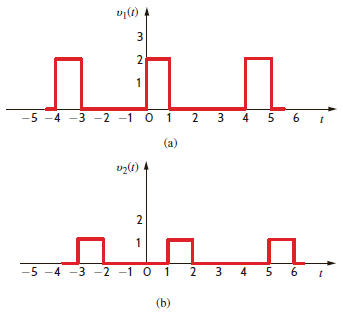
Figure P15.11

Figure P15.11

فتح الحزمة
افتح القفل للوصول البطاقات البالغ عددها 94 في هذه المجموعة.
فتح الحزمة
k this deck
68
Find the trigonometric Fourier series coefficients for the waveform in Fig. P15.19.

Figure P15.19

Figure P15.19

فتح الحزمة
افتح القفل للوصول البطاقات البالغ عددها 94 في هذه المجموعة.
فتح الحزمة
k this deck
69
Compute the first four terms of the amplitude and phase spectra for the periodic signal defined in Problem 15.17.
Problem 15.17
Find the trigonometric Fourier series for the voltage waveform shown in Fig. P15.17.
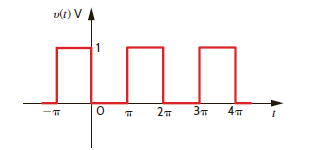
Figure P15.17
Problem 15.17
Find the trigonometric Fourier series for the voltage waveform shown in Fig. P15.17.

Figure P15.17

فتح الحزمة
افتح القفل للوصول البطاقات البالغ عددها 94 في هذه المجموعة.
فتح الحزمة
k this deck
70
Derive the following properties of the Fourier transform.
(a) [ e j 0 t f ( t )] = F ( 0 )
(b)
![Derive the following properties of the Fourier transform. (a) [ e j 0 t f ( t )] = F ( 0 ) (b)](https://d2lvgg3v3hfg70.cloudfront.net/SM4993/11eb71f4_a44e_0fab_b53a_1d4b77deda17_SM4993_00.jpg)
(a) [ e j 0 t f ( t )] = F ( 0 )
(b)
![Derive the following properties of the Fourier transform. (a) [ e j 0 t f ( t )] = F ( 0 ) (b)](https://d2lvgg3v3hfg70.cloudfront.net/SM4993/11eb71f4_a44e_0fab_b53a_1d4b77deda17_SM4993_00.jpg)

فتح الحزمة
افتح القفل للوصول البطاقات البالغ عددها 94 في هذه المجموعة.
فتح الحزمة
k this deck
71
Compute the 1- energy content of the signal v o ( t ) in Fig. P15.64 in the frequency range from = 2 to = 4 rad/s.
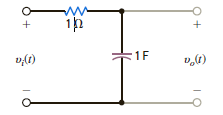
Fig. P15.64

Fig. P15.64

فتح الحزمة
افتح القفل للوصول البطاقات البالغ عددها 94 في هذه المجموعة.
فتح الحزمة
k this deck
72
Find the exponential Fourier series for the signal shown in Fig. P15.4.

Figure P15.4

Figure P15.4

فتح الحزمة
افتح القفل للوصول البطاقات البالغ عددها 94 في هذه المجموعة.
فتح الحزمة
k this deck
73
Determine the expression for the steady-state current i ( t ) in Fig. E15.12 if the input voltage v S ( t ) is given by the expression

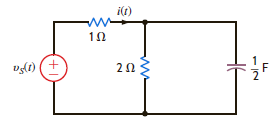
Figure E15.12


Figure E15.12

فتح الحزمة
افتح القفل للوصول البطاقات البالغ عددها 94 في هذه المجموعة.
فتح الحزمة
k this deck
74
Compute the 1- energy content of the signal v i ( t ) = e 2 t u ( t ) V in the frequency range from 0 to 1 rad/s.

فتح الحزمة
افتح القفل للوصول البطاقات البالغ عددها 94 في هذه المجموعة.
فتح الحزمة
k this deck
75
For the amplitude and phase spectra shown in Fig. P15.34, express the function as a sum of sinusoidal functions using the Fourier series coefficients a n and b n.
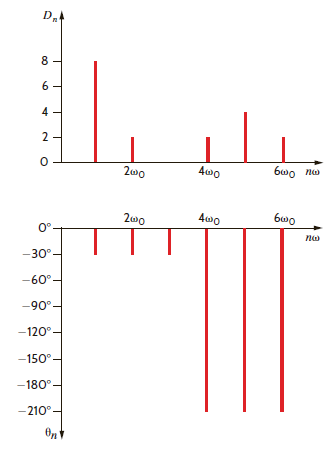
Figure P15.34

Figure P15.34

فتح الحزمة
افتح القفل للوصول البطاقات البالغ عددها 94 في هذه المجموعة.
فتح الحزمة
k this deck
76
Find the Fourier transform of the function f ( t ) = te at u ( t ).

فتح الحزمة
افتح القفل للوصول البطاقات البالغ عددها 94 في هذه المجموعة.
فتح الحزمة
k this deck
77
Determine the 1- energy content of the signal v o ( t ) in Fig. P15.64 in the frequency range from 0 to 1 rad/s.
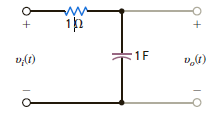
Fig. P15.64

Fig. P15.64

فتح الحزمة
افتح القفل للوصول البطاقات البالغ عددها 94 في هذه المجموعة.
فتح الحزمة
k this deck
78
Find the trigonometric Fourier series for the voltage waveform in Fig. E15.2.
Fig. E15.2
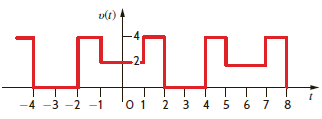
Fig. E15.2


فتح الحزمة
افتح القفل للوصول البطاقات البالغ عددها 94 في هذه المجموعة.
فتح الحزمة
k this deck
79
Given the waveform in Fig. P15.12, determine the type of symmetry that exists if the origin is selected at (a) l 1 and (b) l 2.

Figure P15.12

Figure P15.12

فتح الحزمة
افتح القفل للوصول البطاقات البالغ عددها 94 في هذه المجموعة.
فتح الحزمة
k this deck
80
Find the trigonometric Fourier series for the periodic waveform shown in Fig. P15.20.
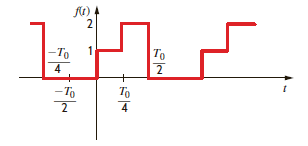
Figure P15.20

Figure P15.20

فتح الحزمة
افتح القفل للوصول البطاقات البالغ عددها 94 في هذه المجموعة.
فتح الحزمة
k this deck








